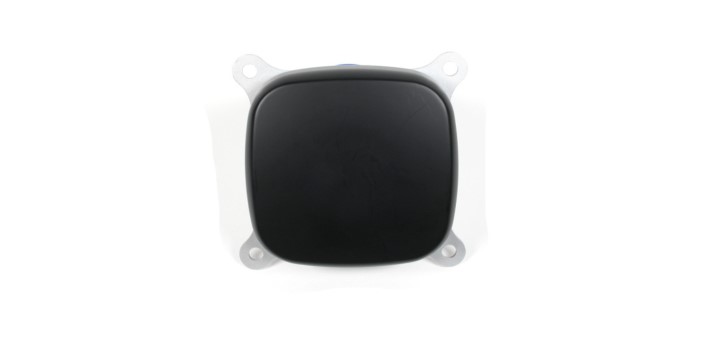RADWIN TRBR600G TERRABRIDGE Radio Transceiver User Manual
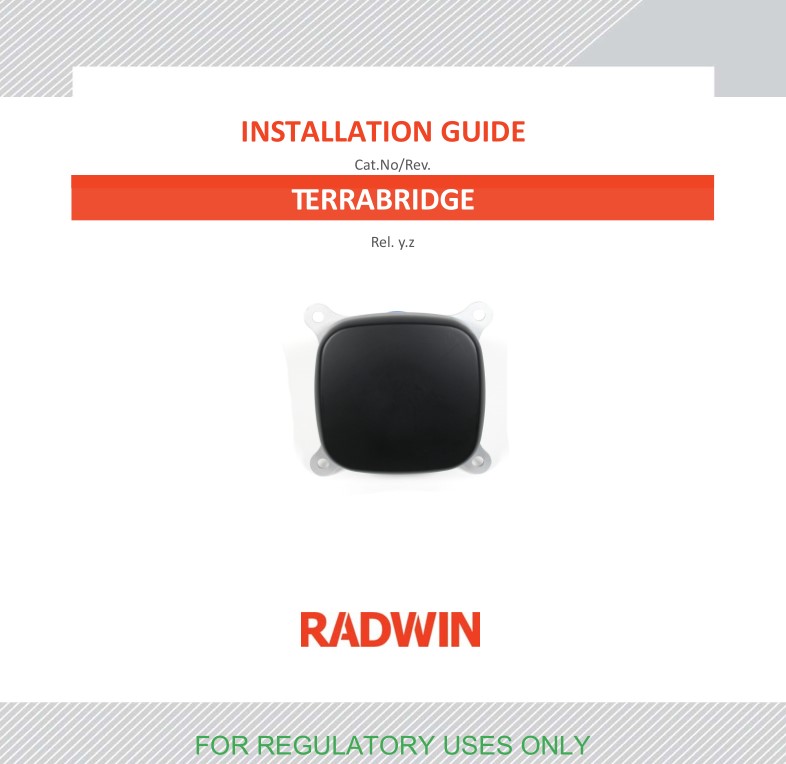
Chapter 1: Introduction
1.1 Scope of this Document
This document shows how to install and configure the TerraBridge radio units.
1.2 Overview
TerraBridge is a millimeter-wave radio unit that provides up to 1.5 Gbps aggregated wireless connectivity between railroad cars. The product enables Gbps Ethernet network throughout the train, seamlessly supporting dynamic changes in the train consist.
The unit complies with outdoor spec IP-69K. It is small and lightweight, which allows it to be mounted out of the way in convenient locations.
1.3 Basic Working Model
Show two train cars, with two TerraBridges on each.
Show how each TerraBridge is connected to the network and power from within the train car.
Mention the GUI.
1.4 Main Features
Radio based on 802.11ad standard in mm-waves unlicensed band
Capacity of up to 1.5 Gbps aggregated
Spectrum: mmWave / 60GHz
Throughput: 1.5Gbps
Delay:1-3msec
Power: PoE GbE interface, 802.3af
Connector:M-12 X-coded connector
Environmental: IP69 (high pressure water jet at 80deg C)
Railway standards: EN50155, EN 50121 and EN61373, IEC 60571
Antenna:Integrated inside the radio unit
1.5 Mechanical Specifications
Show a mechanical drawing including the locations of the screws and the M12 X (PoE) connection
Size (HxWxD): 12x12x2.25 cm
Weight
Operating Temperature
Chapter 2: Installation Steps
To install and establish a basic connection with a radio unit, carry out the steps shown below. Print out this list, and place a checkmark next to a completed task.
2.1 Prepare Laptop
Configure IP address and subnet mask of laptop as follows:
- Control Panel -> Network and Internet -> Network and Sharing Center -> Change Adapter settings -> click on Network Interface Card name
- Properties -> Select Internet Protocol Version 4 (TCP/IPv4) -> Properties -> set IP address to 10.0.0.100 and Subnet mask to 255.255.255.0
2.2 Connect Laptop to Radio Unit
Connect PoE to power, connect the laptop’s ethernet port to the IN (or LAN) socket on the PoE, then connect the OUT (or PoE) socket on the PoE to the M-12 X port on the radio unit. Make sure you are using the appropriate PoE for your specific radio unit.
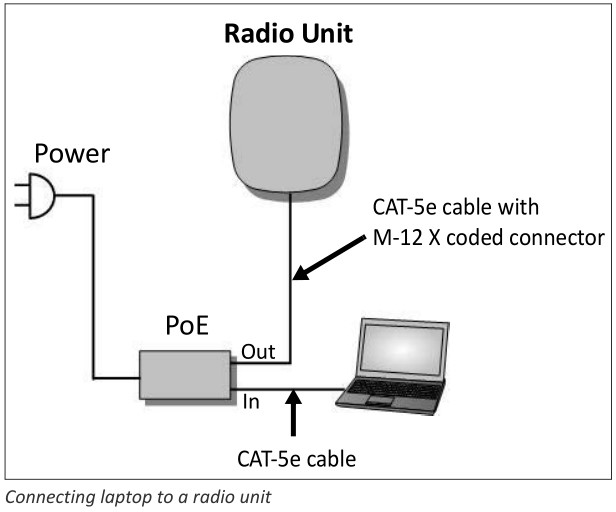
Connect to -> Input socket (not labeled)
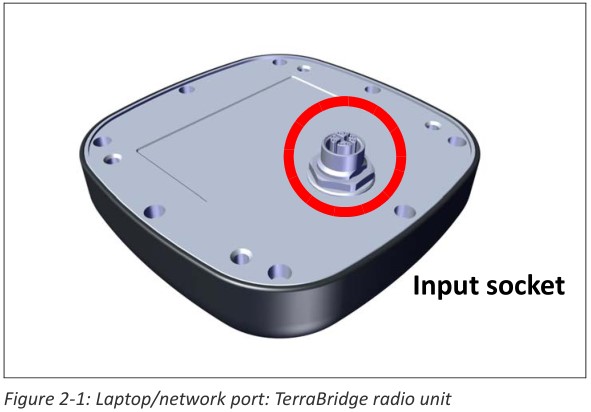
2.3 Update Connectivity Parameters of Radio Unit
Make sure you have Google Chrome or Microsoft Edge installed
Log on to the device via web browser – http://10.0.0.130/ (default IP)
Enter the username – root
Enter the password – admin
You will be prompt to change the username and password for the first‐time login
Under “Setting”→ “Network Settings” configure the device IP (DHCP/Static)
Under “Settings” → “System” configure device NTP server IP
Add a few screens here
2.4 Prepare Items to be Installed
- Radio unit (including mounting plate)
- Screws and bolts
- PoE (if used), including ethernet cable with M12 X connector
- Ethernet cables
- Grounding cable (10 AWG)
2.5 Prepare Tools
- Crimping tool
- Spanner/wrench 13mm (1/2”)
- Cable ties
- Drill and appropriate bits to make holes for PoE and bolts
2.6 Prepare Railroad Car
- Determine where on the cars the units will be fastened.
- It is required that you choose a specific location and keep that location for all cars that will receive the TerraBridge.
- We recommend using two units on each car (see Figure 2-2, Two units on each car).
- The units must be opposite each other.
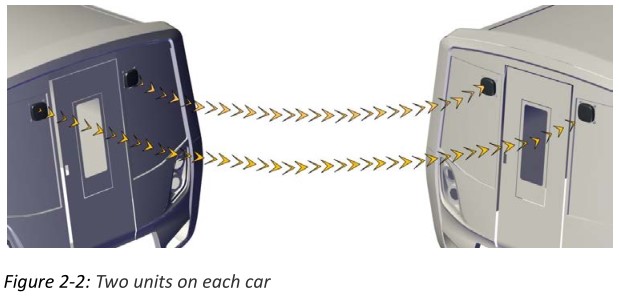
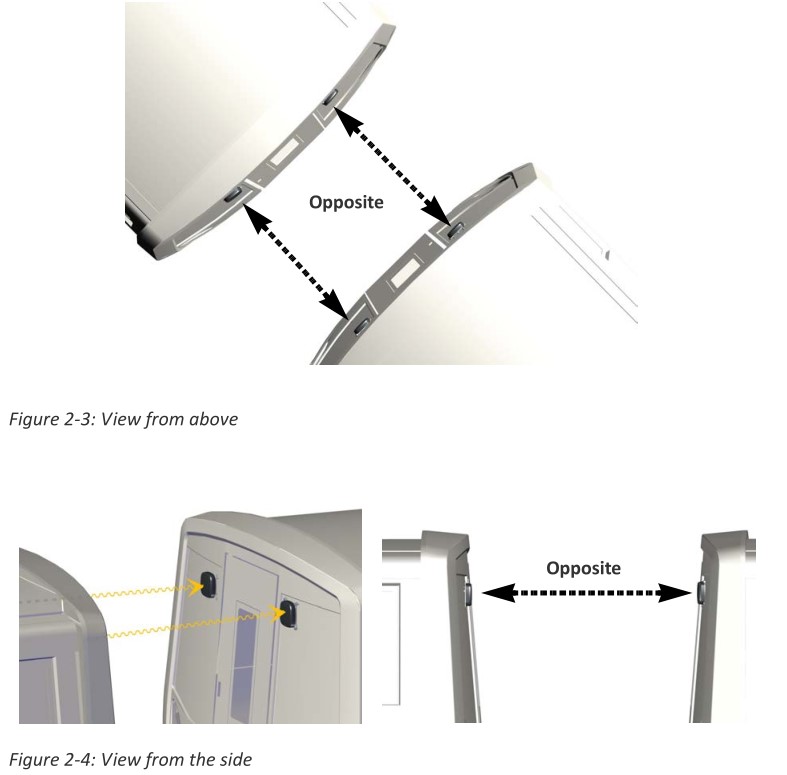
2.7 Prepare PoE
You can use a RADWIN- supplied PoE unit, or the power supply on the car fulfilling the following criteria:
2.8 Mount Unit
You can mount the unit with the base plate or without the base plate.
2.8.1 Without the Base Plate
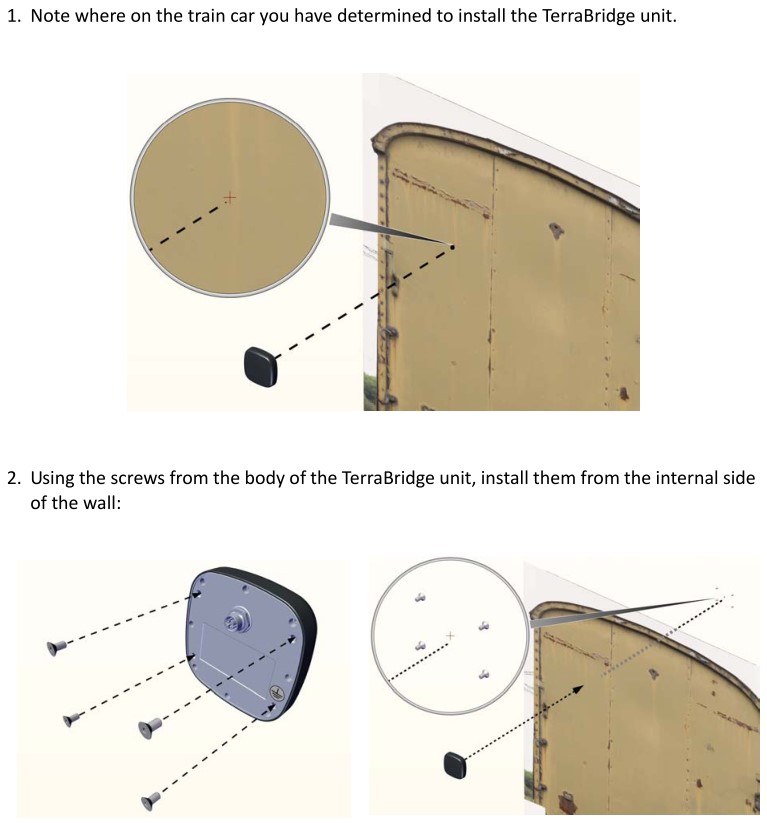
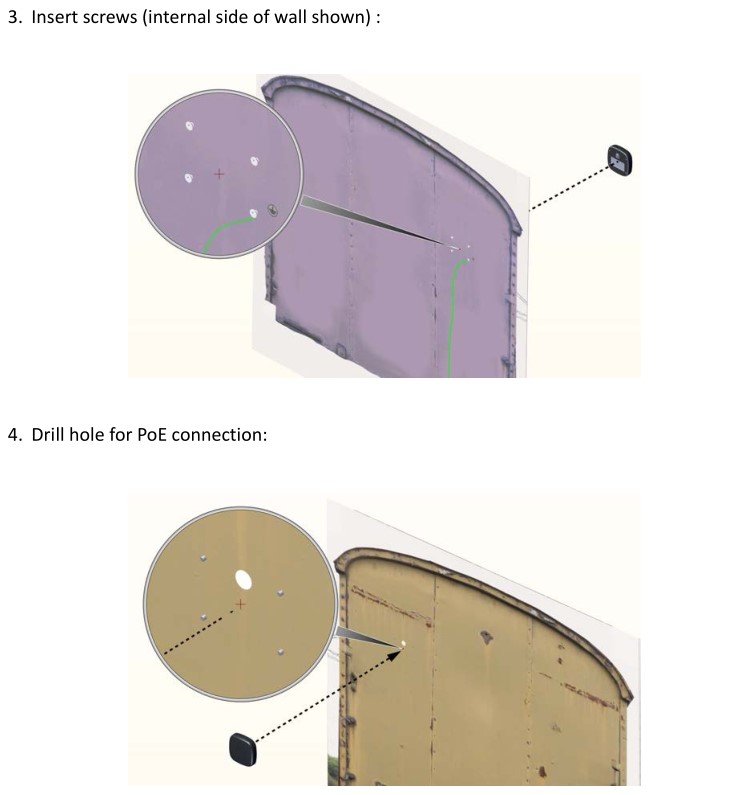

2.8.2 With the Base Plate
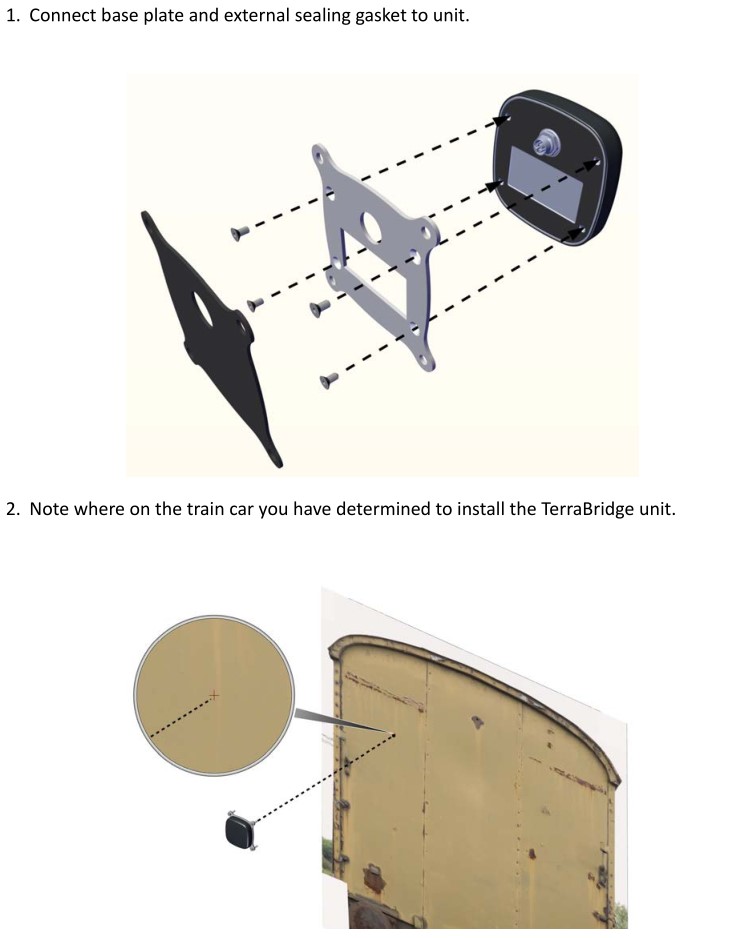
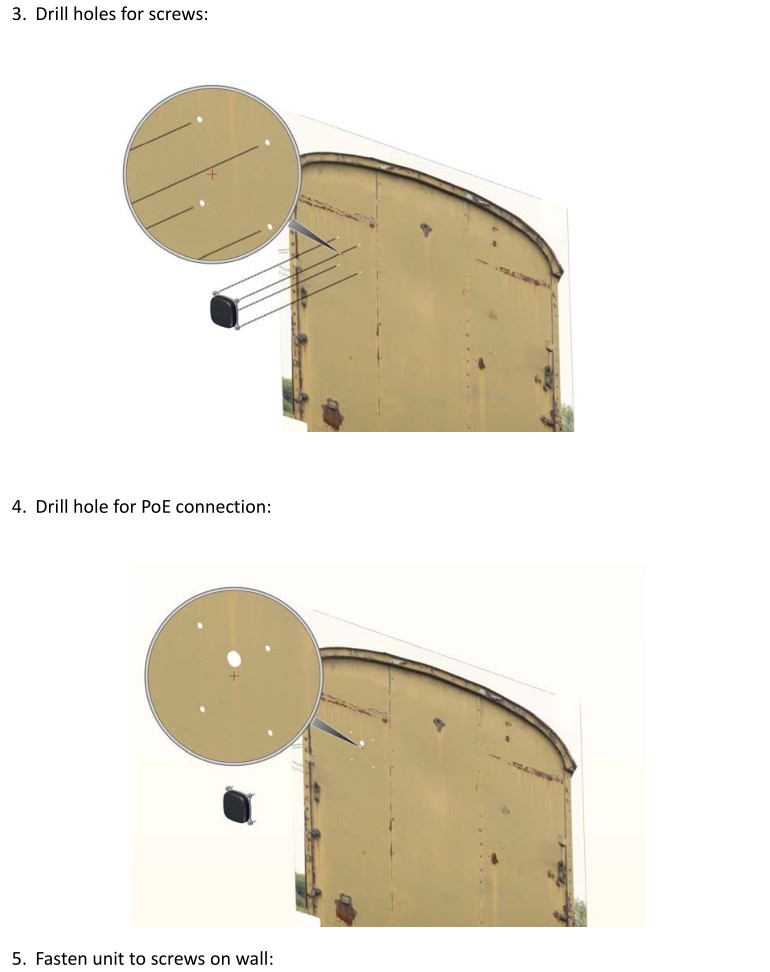
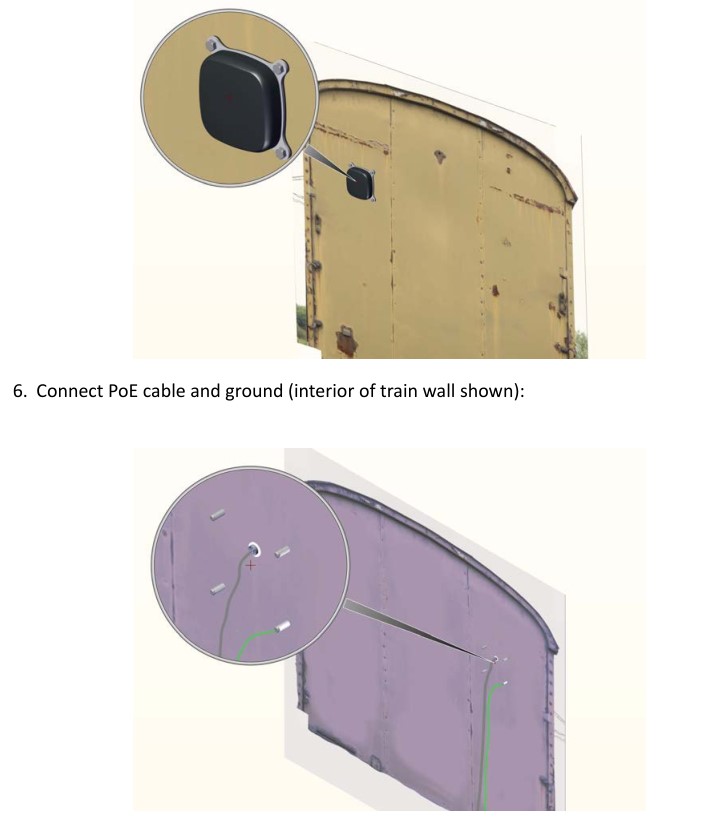
2.9 Ground Unit
Connect a 10 AWG cable to one of the mounting screws on the plate, or one of the inner screws. This depends on if you are using the base plate or not.
2.9.1 With the Base Plate
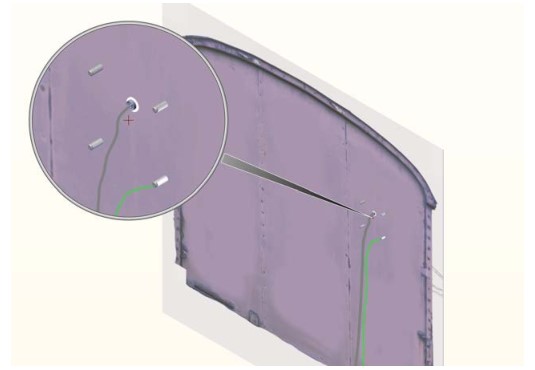
2.9.2 Without the Base Plate
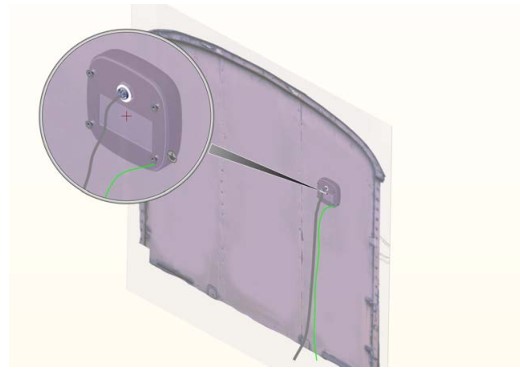
2.10 Connect Radio
Connect special cable that we supply, with PoE or on-board supply.
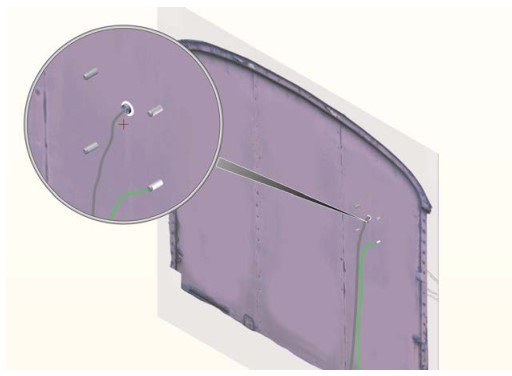
2.11 Check Connectivity to Radio
Ping the installed unit. Show figure
2.12 Verify Link
I’m not sure we need this, but it’s in the PP presentation, so I’m adding it here.
Install second device by repeating step 1‐2
Make sure not to use the same IP (for example – 10.0.0.131)
Once the device is configured, face the 2 devices one another (distance 30cm‐50cm)
Connect your PC to the unit via a PoE, either directly, or via your local network
Ping from device 1 to device 2 to confirm connectivity
Login to both devices (web UI) to verify link status from the “Dashboard” tab
Appendix A: Certified Antennas
A.1 For Deployment in US/Canada
TerraBridge bears the following FCC/IC IDs on the label, refer to the table below:
FCC ID: Q3K-TRBR600G
IC: 5100A-TRBR600G
TerraBridge must be installed so as to provide a minimum separation distance from bystanders as specified in the table below:
Table A-1: Frequency Band 60 GHz

Regulatory Compliance
General Note
This system has achieved Type Approval in various countries around the world. This means that the system has been tested against various local technical regulations and found to comply. The frequency bands in which the system operates may be “unlicensed” and in these bands, the system can be used provided it does not cause interference.
For information on the restrictions on putting the device into service please contact your national telecommunication authorities.
FCC/ISED – Compliance
This equipment has been tested and found to comply with the limits for a Class B digital device, pursuant to Part 15 of the FCC Rules. These limits are designed to provide reasonable protection against harmful interference in a residential installation. This equipment generates, uses and can radiate radio frequency energy and, if not installed and used in accordance with the instructions, may cause harmful interference to radio communications. However, there is no guarantee that interference will not occur in a particular installation. If this equipment does cause harmful interference to radio or television reception, which can be determined by turning the equipment off and on, the user is encouraged to try to correct the interference by one or more of the following measures:
- Reorient or relocate the receiving antenna.
- Increase the separation between the equipment and receiver.
- Connect the equipment into an outlet on a circuit different from that to which the receiver is connected.
Consult the dealer or an experienced radio/TV technician for help.
Changes or modifications to this equipment not expressly approved by the party responsible for compliance could void the user’s authority to operate the equipment.
This device contains licence-exempt transmitter(s)/receiver(s) that comply with Innovation, Science and Economic Development Canada’s licence-exempt RSS(s). Operation is subject to the following two conditions:
- This device may not cause interference.
- This device must accept any interference, including interference that may cause undesired operation of the device.
RF Exposure
For the safety of the general public it is recommended to keep a minimum safe distance from radiating antennas according to Table A-1.
Indoor Units comply with part 15 of the FCC rules. Operation is subject to the following two conditions:
- These devices may not cause harmful interference.
- These devices must accept any interference received, including interference that may cause undesired operation.
![]()
Outdoor units and antennas should be installed ONLY by experienced installation professionals who are familiar with local building and safety codes and, wherever applicable, are licensed by the appropriate government regulatory authorities. Failure to do so may void the product warranty and may expose the end user or the service provider to legal and financial liabilities. Resellers or distributors of this equipment are not liable for injury, damage or violation of regulations associated with the installation of outdoor units or antennas. The installer should configure the output power level of antennas according to country regulations and antenna type.
![]()
- Where Outdoor units are configurable by software to Tx power val- ues other than those for which the product is certified, it is the responsibility of the Professional Installer to restrict the Tx power to the certified limits.
- This product was tested with special accessories – indoor unit (IDU or PoE), FTP CAT-5e shielded cable with sealing gasket, 16 AWG ground- ing cable – which must be used with the unit to insure compliance.
![]()
The system must be professionally installed to ensure compliance with the Part 15 certification. It is the responsibility of the operator and professional installer to ensure that only certified systems are deployed in the United States. The use of the system in any other combination (such as co-located antennas transmitting the same information) is expressly forbidden. The radio must be installed and used in strict accordance with the manufacturer’s instructions as described in this guide. Any other installation or use of the product violates FCC Part 15 regulations.
![]()
It is the responsibility of the installer to ensure that when using the outdoor antenna kits in the United States (or where FCC rules apply), only those antennas certified with the product are used. The use of any antenna other than those certified with the product is expressly forbidden by FCC rules 47 CFR part 15.204. A list of approved external antennas can be found in the Certified Antennas appendix.
![]()
It is the responsibility of the operator and professional installer to ensure that when configuring the radio in the United States (or where FCC rules apply), the Tx power is set according to the values for which the product is certified. The use of Tx power values other than those, for which the product is certified, is expressly forbidden by FCC rules 47 CFR part 15.204
![]()
Under regulatory environments supporting other than FCC/ISED rules: Where Outdoor units are configurable by software to Tx power values other than those for which the product is certified, it is the responsibility of the Professional Installer to restrict the Tx power to the certified limits.
This product was tested with special accessories indoor unit (IDU or PoE), FTP CAT-5e shielded cable with sealing gasket, 16 AWG grounding cable – which must be used with the unit to insure compliance.
Canadian Emission Requirements for Indoor Units
This Class B digital apparatus complies with Canadian ISED-003.
![]()
The radio devices in this manual have been approved by Industry Canada to operate with the antenna types listed in the Certified Antennas appendix with the maximum permissible gain and required antenna impedance for each antenna type indicated. Antenna types not included in this list, having a gain greater than the maximum gain indicate for that type, are strictly prohibited for use with this device.
EU - Compliance
![]()
For Norway and Sweden only
Equipment connected to the protective earthing of the building installation through the mains connection or through other equipment with a connection to protective earthing – and to a cable distribution system using coaxial cable, may in some circumstances create a fire hazard. Connection to a cable distribution system has therefore to be provided through a device providing electrical isolation below a certain frequency range (galvanic isolator, see EN 60728-11).
Unregulated
In countries where the radio is not regulated the equipment can be operated in any regulation configuration, best results will be obtained using Universal regulation configuration.
Safety Practices
Applicable requirements of National Electrical Code (NEC), NFPA 70; and the National Electrical Safety Code, ANSI/IEEE C2, must be considered during installation.
NOTES:
- A Primary Protector is not required to protect the exposed wiring as long as the exposed wiring length is limited to less than or equal to 140 feet, and instructions are provided to avoid exposure of wiring to accidental contact with lightning and power conductors in accordance with NEC Sections 725-54 (c) and 800-30.
In all other cases, an appropriate Listed Primary Protector must be provided. Refer to Articles 800 and 810 of the NEC for details. - For protection of ODU against direct lightning strikes, appropriate requirements of NFPA 780 should be considered in addition to NEC.
- For Canada, appropriate requirements of the CEC 22.1 including Section 60 and additional requirements of CAN/CSA-B72 must be considered as applicable.
- Only UL Listed parts and components will be used for installation. Use UL Listed devices having an environmental rating equal to or better than the enclosure rating to close all unfilled openings.
- Use min. 16 AWG external protective earthing conductor.
- Installation altitude is limited to a maximum of 2000 meters (6,560 ft.).
TerraBridge
Installation Guide
Notice
This handbook contains information that is proprietary to RADWIN Ltd (RADWIN hereafter). No part of this publication may be reproduced in any form whatsoever without prior written approval by RADWIN.
Right, title and interest, all information, copyrights, patents, know-how, trade secrets and other intellectual property or other proprietary rights relating to this handbook and to the RADWIN products and any software components contained therein are proprietary products of RADWIN protected under international copyright law and shall be and remain solely with RADWIN.
The RADWIN name is a registered trademark of RADWIN. No right, license, or interest to such trademark is granted hereunder, and you agree that no such right, license, or interest shall be asserted by you with respect to such trademark.
You shall not copy, reverse compile or reverse assemble all or any portion of the Installation Guide or any other RADWIN documentation or products. You are prohibited from, and shall not, directly or indirectly, develop, market, distribute, license, or sell any product that supports substantially similar functionality based or derived in any way from RADWIN products.Your undertaking in this paragraph shall survive the termination of this Agreement.
This Agreement is effective upon your opening of a RADWIN product package and shall continue until terminated. RADWIN may terminate this Agreement upon the breach by you of any term thereof. Upon such termination by RADWIN, you agree to return to RADWIN any RADWIN products and documentation and all copies and portions there of.
For further information contact RADWIN at one of the addresses under Worldwide Contacts below or contact your local distributor.
Disclaimer
The parameters quoted in this document must be specifically confirmed in writing before they become applicable to any particular order or contract. RADWIN reserves the right to make alterations or amendments to the detail specification at its discretion. The publication of information in this document does not imply freedom from patent or other rights of RADWIN, or others.
Trademarks
WinLink 1000, RADWIN 2000, RADWIN 5000, RADWIN 6000, RADWIN 600 and FiberinMotion are trademarks of RADWIN Ltd.
Windows 2000, XP Pro, Vista, Windows 7 and Internet Explorer are trademarks of Microsoft Inc.
Mozilla and Firefox are trademarks of the Mozilla Foundation.
Other product names are trademarks of their respective manufacturers.

